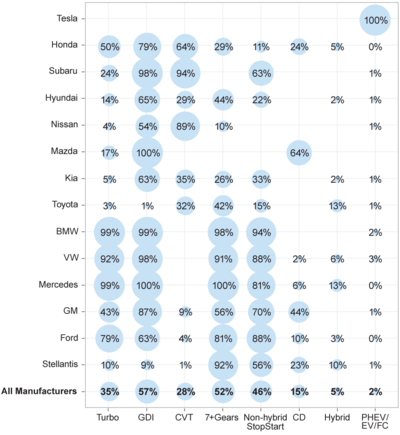EV Propagandist's Now Include Hybrid Vehicles As 'Electrified" To Overstate BEV Adoption Fairy-tale
 |
Mmanufacturers continue to adopt a wide array of advanced technologies
Innovation in the automobile industry has led to a wide array of technology available to manufacturers to achieve CO2 emissions, fuel economy, and performance goals. Figure ES-5 (below) illustrates manufacturer-specific technology adoption for model year 2020, with larger circles representing higher adoption rates. The technologies in Figure ES-5 are all being adopted by manufacturers to in part reduce CO2 emissions and increase fuel economy. Each of the fourteen largest manufacturers have adopted several of these technologies into their vehicles, with many manufacturers achieving very high penetrations of several technologies. It is also clear that manufacturers’ strategies to develop and adopt new technologies are unique and vary significantly. Each manufacturer is choosing technologies that best meet the design requirements of their vehicles, and in many cases, that technology is changing quickly.
Engine technologies such as turbocharged engines (Turbo) and gasoline direct injection (GDI) allow for more efficient engine design and operation. Cylinder deactivation (CD) allows for use of only a portion of the engine when less power is needed, while stop/start systems can turn off the engine entirely at idle to save fuel. Hybrid vehicles use a larger battery to recapture braking energy and provide power when necessary, allowing for a smaller, more efficiently operated engine. The hybrid category includes “full” hybrid systems that can temporarily power the vehicle without engaging the engine and smaller “mild” hybrid systems that cannot propel the vehicle on their own. Transmissions that have more gear ratios, or speeds, allow the engine to more frequently operate near peak efficiency. Two categories of advanced transmissions are shown in Figure ES-5: transmission with seven or more discrete speeds (7+Gears), and continuously variable transmissions (CVTs).
Electric vehicles (EVs), plug-in hybrid vehicles (PHEVs), and fuel cell vehicles (FCVs) are a small but growing percentage of new vehicles. Projected data for model year 2021 supports this, as EVs, PHEVs, and FCVs are projected to grow to 4% of all new vehicles. Hybrids (not including PHEVs) are also projected to grow significantly in model year 2021, to 9% of all vehicles produced. Hybrid production is expected to grow in most vehicle types, including truck SUVs and pickups. Approximately one third of these hybrids are projected to be mild hybrids.
Figure ES-5. Technology Share for Large Manufacturers, Model Year 2020



